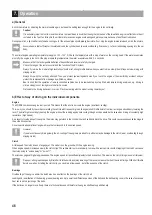
33
• Only use suitable containers to transport fuel.
• The fuel can corrode or damage paint and rubber parts.
• Empty fuel containers as well as remaining fuel must be disposed of as hazardous waste.
• Do not throw fuel containers into fire!
c) Operation
• Getting started:
Check all screw connections and wheel nuts.
Make sure that the rechargeable batteries of both the transmitter and the receiver are fully charged.
Put the pistol grip remote control in neutral position. To do that, let go of the throttle and the steering control wheel. Always switch on the transmitter before you
switch on the receiver.
• Never drive the model if your ability to respond is restricted (e.g. when tired on under the influence of medication or alcohol). Faulty reactions can cause
serious personal or material damage.
• Do not steer the model towards groups of people, individuals, or animals!
• Always keep visual contact to the model! Do not drive at night.
• Never drive the model on public roads! Observe the applicable conditions and regulations for the site.
• The model must not be used indoors!
• Never operate it without an air filter!
• Regularly check all screw connections and attachments as they might become loose or come off due to engine vibration during operation.
• Avoid driving in the part-load operating range for a long time! The engine and the clutch can overheat due
to missing air cooling!
• Avoid driving at extremely low outdoor temperatures. In a cold environment, the plastic of the vehicle body loses its elasticity so that otherwise insignificant
accidents may cause spalling or cracking.
d) Remote control
• Before starting, check the range of your remote control.
• Check the charge level indicator of your remote control! Weak or empty rechargeable batteries (or normal batteries) can result in you losing control of your
model.
• Firmly screw tight the transmitter aerial and extend it to its full length. If the aerial is not fully extended, the range of the remote control is reduced.
• Make sure that the throttle/brake servo is in neutral position before you start the engine.
• While the model is not moving, check if the servos respond to the remote commands as
expected!
• Secure excess lengths and loose cables with thin cable ties! Especially make sure that no cables can get caught in moving parts.
• Make sure that no-one else in your proximity is transmitting on your frequency! Interfering signals on the same frequency can result in you losing control of
your model. Even when using different modulation types (FM, PPM, AM, PCM), the same frequency must not be used.
• Do not drive under high-voltage power lines or radio masts.
• Do not drive during a thunderstorm! Atmospheric interferences can affect the signals of your remote control.
• Do not drive in the rain, through water, wet grass, mud, or snow. The components of the RC system are not water-proof!
• Always leave the remote control and the receiver switched on as long as the engine is running!
• Switching off: First switch off the engine before you switch off the receiver followed by the transmitter!
e) Batteries and rechargeable batteries
• Remove the rechargeable battery from the receiver if it is not used over a longer period of time.
• Never mix rechargeable batteries with dry-cell batteries.
• Never mix full and half-full batteries or batteries with different capacities. Otherwise, the weaker batteries or the batteries with lower capacity can be totally
discharged and leak.
• Never try to recharge dry-cell batteries. Risk of explosion!
• Dispose of empty, defective batteries or batteries that cannot be recharged anymore properly (see chapter on "Disposal").
Summary of Contents for 23 68 22: RtR
Page 114: ...114 ...
Page 115: ...115 ...
















































